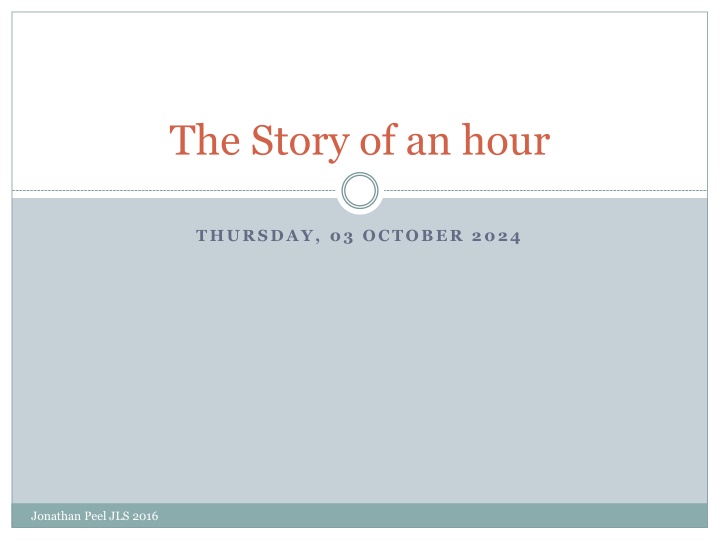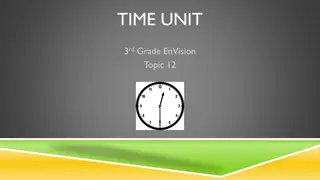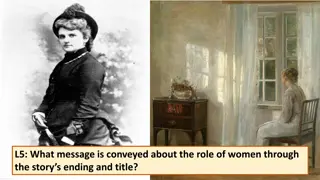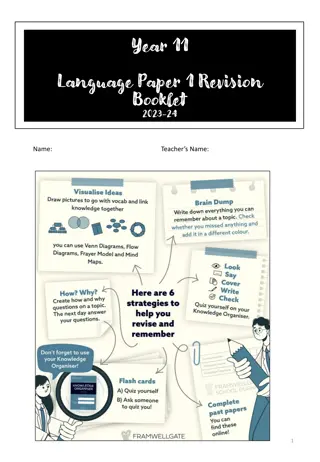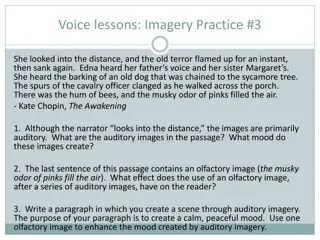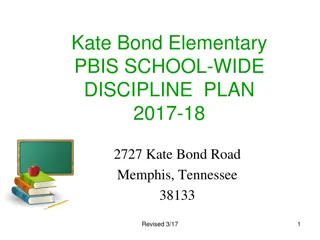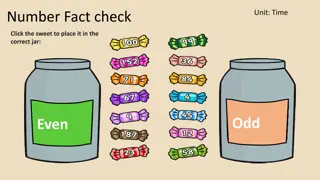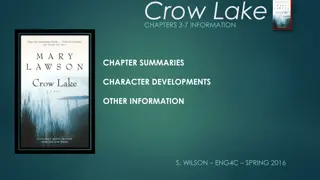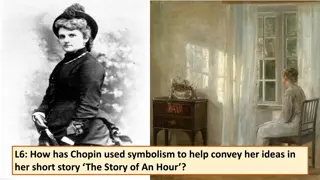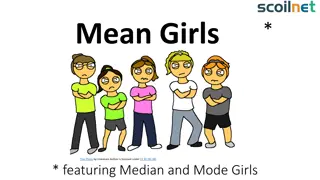Insights into "The Story of an Hour" by Kate Chopin
Explore the themes and character focus in Kate Chopin's "The Story of an Hour," set around the turn of the 20th century. Delve into the intimate setting, Mrs. Mallard's emotional journey, and the symbolic elements like the open window. Discover how the concise, high-impact genre of the short story effectively conveys irony and societal critiques.
Download Presentation

Please find below an Image/Link to download the presentation.
The content on the website is provided AS IS for your information and personal use only. It may not be sold, licensed, or shared on other websites without obtaining consent from the author.If you encounter any issues during the download, it is possible that the publisher has removed the file from their server.
You are allowed to download the files provided on this website for personal or commercial use, subject to the condition that they are used lawfully. All files are the property of their respective owners.
The content on the website is provided AS IS for your information and personal use only. It may not be sold, licensed, or shared on other websites without obtaining consent from the author.
E N D
Presentation Transcript
The Story of an hour THURSDAY, 03 OCTOBER 2024 Jonathan Peel JLS 2016
Kate Chopin 19th Century American From Southern USA, lived in Alabama. A very Conservative area with a social code based on race and gender Feminist writer Female characters often explore ideas which would offend polite society: race, marriage, sexuality, promiscuity Was not accepted by society due to the offensive subject matter of her work. Jonathan Peel JLS 2016
Genre of Short Story Condensed No back story No room to project forward High impact Especially good for conveying irony Thomas Hardy and Roald Dahl for example Jonathan Peel JLS 2016
A SCASI approach : SETTING Time when, time era, place, nature No time of day is specified. The action takes around half a day at most. Intense The piece is set contemporaneously, somewhere around the turn of the 20th Century. What implications does this have for the gender politics of the writing? Most of the story takes place in her room Jonathan Peel JLS 2016
In her room She seeks privacy and solitude The room is not described but the comfortable armchair is. She will sit here to wait for the epiphany- why does Chopin stress its comfort? The window is open. What might this symbolise? Consider what she sees through it (nature) Jonathan Peel JLS 2016
Through the window Windows are often symbols of the boundary between an old and a new life: liminality . What she sees What this might symbolise Trees all aquiver with new Spring life The notes of a distant song reached her faintly Countless sparrows Patches of blue sky The sounds, the scents, the colour that filled the air Jonathan Peel JLS 2016
Character Focus is Mrs Mallard Looking for description in early sections of the tale: Quotation Effect Heart trouble ambiguous: implying both health and emotion Emotional and passionate She wept at once: Storm of grief Went away to her room alone Facing the open window pressed down by a physical exhaustion Jonathan Peel JLS 2016
Development The open window is the clue. What does she realise that the death of her husband will allow? She sobs continuously what might this suggest? Why has she a dull stare prior to her epiphany? Jonathan Peel JLS 2016
Epiphany: Free, free, free Find as many concepts which connote freedom as you can. Once she recognises her potential freedom, how does Chopin show it taking over her entire being, in paragraphs 10&11? What is the significance of her being described as a goddess of Victory ? What is the irony of the final sentence? What has she died of? Jonathan Peel JLS 2016
Action Not much happens: Mrs Mallard takes to her room and comes out again. She dies. Consider the description of the realisation of freedom. Can you find examples of the sensation seeming to have a sense of physical movement in paragraphs 9- 12? Jonathan Peel JLS 2016
Style: Chopin writes with a range of emotive hyperbole, especially of adjective and of verb choice. Short paragraphs move the story forward to its conclusion Sentences are short and full of power due to the heightened language What is the significance of the few moment s of direct speech? Poetic diction is evident inn this heightened language and also in moments of alliteration and of assonance revealed-concealing , composedly carrying Se if you can find moments of antithesis and of repetition (including tricolon) Jonathan Peel JLS 2016
IDEAS: FREEDOM: from the constraints of marriage. Mrs Mallard loves her husband note she will weep when she sees the kind, tender hands he is not being held up as a figure of entrapment. The love is not consistent - often she had not She is free from the societal constraints of marriage, not freed from a brutal or unkind husband. Chopin equates this freedom with the elixir of life . Why? At the end of the tale, the joy of the freedom kills Mrs Mallard. What point may Chopin be making here? Jonathan Peel JLS 2016
